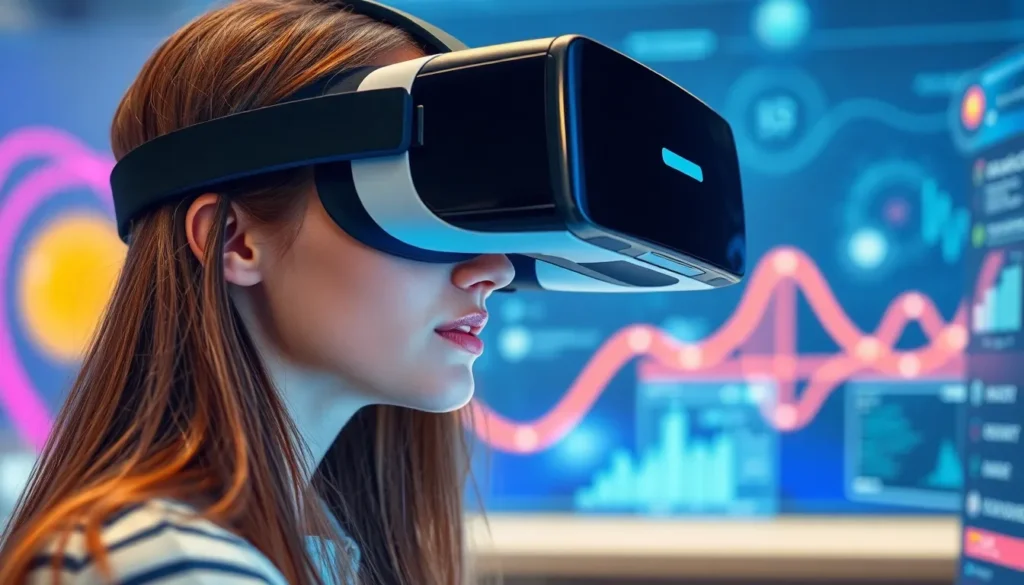Table of Contents
ToggleVirtual reality is transforming the way people approach productivity in the workplace. As technology advances, VR offers immersive experiences that can enhance focus, collaboration, and creativity. This innovative medium allows users to step into a virtual environment where distractions fade away, enabling them to concentrate on tasks like never before.
From virtual meetings to interactive training sessions, VR is reshaping traditional workflows. Companies are increasingly adopting this technology to boost employee engagement and streamline processes. With its potential to create dynamic workspaces, VR not only enhances individual performance but also fosters teamwork and communication among remote teams. As businesses navigate the future of work, understanding the impact of VR on productivity becomes essential for staying competitive.
Understanding VR Productivity
VR productivity refers to the effectiveness and efficiency gains achieved through the use of virtual reality technology in work environments. It encompasses various activities, from immersive training to enhanced collaboration.
Definition of VR Productivity
VR productivity involves utilizing virtual reality tools to improve work outcomes, streamline processes, and foster interaction among team members. It integrates immersive simulations, allowing employees to engage with digital environments that replicate real-world scenarios. This method enhances focus by minimizing external distractions and enabling deeper involvement in tasks.
Importance in the Modern Workspace
VR productivity plays a crucial role in today’s dynamic workplaces. It promotes innovative learning methodologies and effective collaboration, which are essential for adapting to evolving business demands.
Key benefits include:
- Increased Engagement: VR captivates users, enhancing attention and retention, especially during training sessions.
- Enhanced Collaboration: Teams can interact in shared virtual spaces, leading to smoother communication and better problem-solving.
- Cost Efficiency: VR eliminates the need for physical training setups, reducing costs associated with materials and facilities.
- Flexibility and Scalability: VR solutions can be tailored to different scenarios and expanded to accommodate larger teams or varying training needs.
Embracing VR in the workplace enables companies to stay competitive, ensuring employees are well-equipped to tackle challenges in an increasingly digital landscape.
Benefits of VR in Productivity

VR technology significantly boosts productivity in workplace settings through enhanced collaboration, immersive learning experiences, and improved focus.
Enhanced Collaboration
Enhanced collaboration in VR allows teams to engage in real-time interactions despite physical distances. VR platforms enable participants to share virtual workspaces, aiding communication and creativity. Features such as customizable avatars and interactive tools foster a sense of presence, making discussions more impactful. For instance, a team of five can review a 3D model together without being in the same room, increasing synergy and accelerating decision-making.
Immersive Learning Experiences
Immersive learning experiences in VR transform employee training and development. VR simulations provide realistic scenarios that help employees practice skills in safe environments. This method engages participants more effectively than traditional training formats. Studies indicate that learners retain 70% of information presented in VR, compared to only 10% from lectures. Companies adopting VR for training witness shorter onboarding times and enhanced knowledge retention.
Focus and Concentration
Focus and concentration in VR increases through the elimination of real-world distractions. Users enter designed environments tailored for specific tasks, allowing them to immerse fully in their work. Data shows that employees using VR for focused tasks exhibit a 30% increase in productivity. By minimizing distractions and enhancing mental clarity, VR creates optimal conditions for completing complex projects efficiently.
Challenges and Limitations
Virtual reality (VR) technology faces various challenges and limitations that can impact its effectiveness in improving productivity. Understanding these barriers helps organizations make informed decisions regarding VR implementation.
Technical Limitations
VR technology encounters several technical limitations that hinder its widespread adoption. Issues such as motion sickness, which affects approximately 30% of users, can lead to discomfort and decreased productivity during VR sessions. Limited field of view and resolution may prevent optimal immersion, decreasing the effectiveness of training and collaborative experiences. Additionally, hardware costs remain significant, with high-quality headsets priced between $300 and $1,000, leading to budget considerations for businesses. Finally, the need for sophisticated software and IT infrastructure presents barriers for organizations, making seamless integration into existing workflows challenging.
User Adaptation and Comfort
User adaptation and comfort pose additional challenges in the VR workspace. The initial learning curve for VR interfaces can deter users, as many may struggle to navigate new virtual environments. Rapid adaptation techniques can minimize these barriers, yet resistance to change remains a concern. Comfort levels vary among users; some may feel claustrophobic or disoriented, particularly during extended use. To address these issues, organizations must focus on effective onboarding programs, ensuring users receive adequate training and support. Customization options can enhance comfort, allowing users to adjust settings based on personal preferences, thus improving overall engagement and productivity in VR settings.
Future of VR Productivity
The future of VR productivity holds immense potential, driven by emerging trends and advancements in technology. Organizations are poised to leverage VR tools further to enhance workplace efficiency and creativity.
Trends to Watch
- Increased Remote Integration: Virtual reality’s role in remote work will expand. Organizations will adopt VR solutions for seamless virtual meetings and collaborative projects, fostering a sense of presence among distributed teams.
- Adaptive Learning Platforms: VR training platforms will utilize adaptive learning algorithms. These systems will customize training experiences based on individual learner needs, improving knowledge retention.
- Cross-Platform Accessibility: Development of cross-platform VR tools will enhance user accessibility. Employees will transition between devices like headsets, desktops, and mobile devices while maintaining consistent experiences.
- Gamification Techniques: Incorporating gamification in VR training environments will motivate and engage users. Elements such as rewards and challenges will encourage active participation and skill development.
- Advanced Analytics: Enhanced data analytics will track user interactions and productivity levels within VR environments. Companies will leverage this data to refine training methods and assess effectiveness.
Potential Developments
- Improved Hardware: Breakthroughs in VR hardware will lead to lighter, more comfortable headsets. Enhanced graphics and reduced latency will create smoother and more immersive experiences for users.
- AI Integration: Artificial intelligence will be integrated into VR systems, personalizing user experiences and predicting training needs. AI-powered virtual assistants could facilitate interactions during immersive training sessions.
- Social Collaboration Features: Future VR applications may include enhanced social collaboration features. Users could collaborate in shared virtual spaces to brainstorm, strategize, and innovate in real-time, regardless of physical location.
- Scalability Solutions: Solutions enabling scalable VR deployments will emerge, allowing companies to implement VR applications more cost-effectively across different departments and teams.
- Safety Protocols: As VR adoption grows, safety protocols will evolve. Organizations will develop guidelines to address user motion sickness, provide necessary breaks, and ensure comfort for all users during extensive VR sessions.
The integration of virtual reality in the workplace is reshaping how organizations approach productivity. By providing immersive experiences that enhance focus and collaboration, VR is not just a trend but a vital tool for modern businesses. As companies navigate the challenges of remote work and evolving demands, adopting VR solutions can lead to significant gains in employee engagement and efficiency.
With ongoing advancements in technology and user experience, the future of VR productivity looks promising. Organizations that embrace these innovations will not only improve their workflows but also cultivate a more dynamic and adaptable workforce. As VR continues to evolve, its role in enhancing workplace productivity will become increasingly indispensable.







